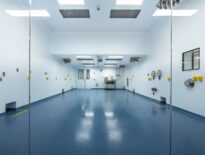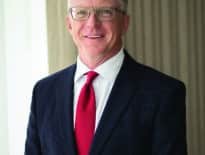
A new life sciences building in Watertown will introduce significant public realm improvements including wider sidewalks with tree plantings welcoming pedestrians to the building’s entry lobby. Image courtesy of Elkus Manfredi Architects
In the wake of the COVID-19 pandemic, the value of the life sciences industry is indisputable. Rapid development of treatments and vaccines shined a light out of a dark time during the pandemic.
Architects and developers support such critical research, in part, by creating environments that foster productivity, community and collaboration among the people entrenched in this important work. From gathering areas where teams can hatch ideas over coffee to technical bench space where researchers dig deep into the science, these hives of discovery are vital to growing our collective scientific knowledge.
Even the most inspiring life sciences building does not immediately make an appealing neighbor in some communities, however, considering the commercial nature of complex mechanical systems or the infrastructure burden of adding new commuters. A way to connect life science facilities with their environment is to introduce a vital component into new developments: public realm improvements. Just as green space and traffic mitigation can appeal to prospective tenants, meaningful public realm enhancements can enrich the communities where they are situated.
Part of Kendall’s Special Sauce
Take Kendall Square in Cambridge as an example. In the shadow of world-renowned research institutions making up the most innovative square mile on the planet, local youngsters play basketball on the same courts as biomedical researchers taking a break from the lab bench. What is a neighborhood benefit for some is a workplace amenity for others; it is a place where diverse groups of people can come together and, perhaps, make a connection over the fascinating science taking place in their midst.
Developers are always looking for the special sauce that is Kendall Square, and these kinds of deliberate and meaningful public realm improvements are one element that creates that chemistry.

Boston Development Group’s life science development at 66 Galen St. in Watertown preserves 40 percent of the site as open space. A pair of terraced parks, including this sloped park at the building’s southeast side, includes plantings and distinct seating pockets. Image courtesy of Elkus Manfredi Architects
As demand for new lab and office space continues in the Boston area, Watertown is emerging as a new life science hub just outside the city. A new building for developers Boston Development Group (BDG) and The Davis Cos. will bring 200,000 square feet of class A office-laboratory space to 66 Galen St.
This underutilized parcel is uniquely situated with access to the Massachusetts Turnpike, proximal to public transportation and just across the Charles River from Watertown Square. Along with distinctive architecture that inserts visual interest in an empty stretch of street, a vital component of this project is the planned improvements to the public realm, including particular attention paid to the pedestrian experience.
Public Realm Enhancements for All
Forty percent of the site will be dedicated to open space. Two parks designed by landscape architects Ground Inc. will provide tenants, visitors and neighbors 44,000 square feet of publicly accessible open space to pause and reflect near the Charles River. One park provides shared gathering space for neighbors and tenants, and the second promotes direct neighborhood access to the Charles River as well as quiet spaces with great views to the waterway.
The building’s placement allows for wider sidewalks and the elimination of multiple curb cuts, as well as new streetscapes on Galen and Water streets. New vehicular and bicycle traffic patterns and infrastructure improvements – including traffic signalization, separated bike lanes and dedicated bus lanes – will improve traffic flow and safety and promote multi-modal transportation, supported by a new bus stop and a bike share station. On-site, below-grade parking for 277 vehicles will reduce parking pressure on the neighborhood, and an on-site retail/café space will be open to the public.

David P. Manfredi
In short, this new development in Watertown introduces worthy public realm enhancements that benefit the whole community – neighbors, commuters, and tenants alike. Construction is underway after the project received approval from the Watertown Zoning Board of Appeals following months of planning discussions and community meetings.
Vibrant, mixed-use amenities and green space definitely appeal to prospective life sciences tenants. It should come as no surprise that inclusive neighborhood benefits, such as those slated for the project in Watertown, also bolster proposals for new developments seeking entitlement.
Aligning public realm improvements with a community’s comprehensive plan can help developers navigate the approvals process to mutually beneficial results. Welcoming outdoor gathering places kindle community among both the researchers and residents, reinforcing opportunities for collaboration. Just as researchers do their best work in spaces that welcome all individuals to connect and collaborate, life sciences buildings work best when they are integrated into the fabric of the city.
David Manfredi is CEO and founding principal of Elkus Manfredi Architects and a fellow of the American Institute of Architects.






